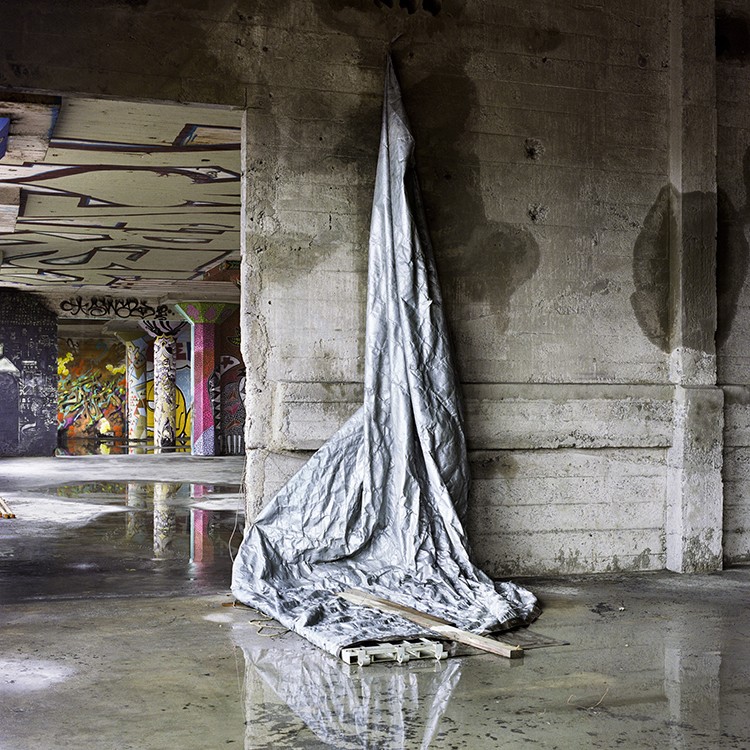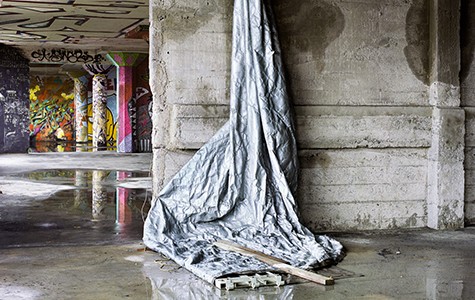In the current show at Berkeley Art Center (1275 Walnut St.), New Photography inspired by the Paul Sack Collection, there’s a photograph by Berkeley photographer Nick Lawrence that represents a strikingly rare composition. It’s a photo taken from inside a long abandoned ink factory in West Berkeley, a specific building made locally famous by the abundance of illegal murals that it once housed. In 2012, it was the site of a legendary underground graffiti exhibition called Special Delivery. And it’s a recognizably familiar setting for work by photographers who fancy themselves urban explorers.

Most photos taken in Berkeley’s “graffiti palace” come off as documentarian, centering the paintings as the focal point of every image. But Lawrence’s take is more poetic. The aforementioned photo shows a mural by GATS — an icon of Bay Area graffiti — but the piece is only half-shown. It’s partially pushed off the right edge of the square frame, almost as if Lawrence had initially set his Hasselblad lens on it, then decided to shift his eye to the left and focus, instead, on a glassless window letting light into the skeletal space, illuminating a puddle at its base.
Over the course of five years, beginning in 2010, Lawrence repeatedly broke into the abandoned factory, initially to take photographs that centered on the graffiti. He was drawn to the lawless display of creativity, and the notion that the graffiti artists were rebelling against the system with their art by claiming ownership of the space. But after Special Delivery, the site’s new owner began to sandblast the walls to prep the building for conversion into offices for his construction company. In witnessing that process, Lawrence found an unexpected appreciation for the raw structure of the building as it transformed — the building itself became his subject rather than the art on it. His works in New Photography reflect that romantic shift. In one of the best, veils of plastic billow gently in front of floor-to-ceiling windows like a ghostly nightgown above a soft carpet of settled sand-blasting residue.
Lawrence is one of six artists in New Photography, a juried show of works that reflect an influence from the illustrious photography collection of Paul Sack. Sack studied art as a young man at the San Francisco Art Institute, but decided to go into real estate to fund his creative interests. Now, he owns one of the most impressive collections of photography in the United States, with a temporal breadth that encompasses the history of photography. As a super successful San Francisco real estate mogul, Sack’s main guiding criteria for his collection is a cheeky requirement that every photo include a structure that he could buy or lease.
As Sandra Phillips, the senior curator of photography for the San Francisco Museum of Modern Art, notes in the museum’s catalogue for its 2005 showcase of Sack’s collection titled Taking Place, that initially casual focus on buildings gradually evolved into a serious endeavor to catalogue ways of capturing built environments throughout history. New Photography is explicitly intended to add to that history, focusing on works that employ the built environment as subject rather than setting.

In one of Maggie Preston’s black and white photos for New Photography, a Victorian house shrouded by a wooden fence and cloaked in mesh material juts into the frame from below, backed by a washed out, white sky. All of her photos in the show feature buildings under construction, similarly wrapped and interjectory. With each photo, which were all taken in post-tech-boom San Francisco, Preston severely showcases the conspicuous cover-ups that are symptomatic of the rapid transformation of the city’s broader environment. As neo-San Francisco attempts to emerge quietly, these ominous structures mark the odd in-between, simultaneously silent and blaring — especially in Preston’s isolating compositions.
Likely unintentionally, some of the most striking work in New Photography is that which takes Sack’s requirement most literally — not only beholding built environments, but those which have recently been bought. In an intriguingly multilayered way, these not only reflect the legacy of an influential collection, but the way that it was financed as well.















